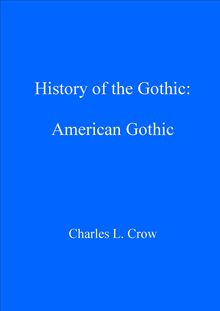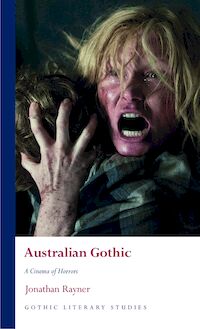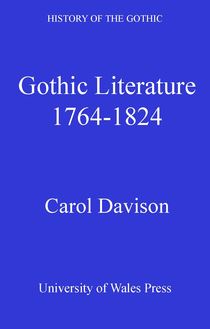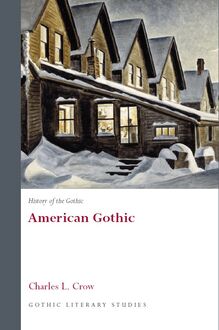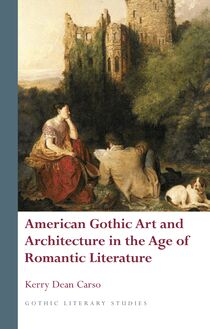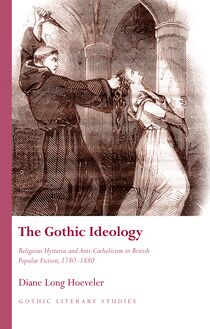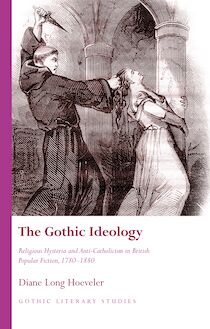Gothic Remains , livre ebook
147
pages
English
Ebooks
2019
Vous pourrez modifier la taille du texte de cet ouvrage
Obtenez un accès à la bibliothèque pour le consulter en ligne En savoir plus
Découvre YouScribe en t'inscrivant gratuitement
Découvre YouScribe en t'inscrivant gratuitement
147
pages
English
Ebooks
2019
Vous pourrez modifier la taille du texte de cet ouvrage
Obtenez un accès à la bibliothèque pour le consulter en ligne En savoir plus
Publié par
Date de parution
01 octobre 2019
Nombre de lectures
0
EAN13
9781786834621
Langue
English
The Gothic has always been fascinated with objects carrying with them a sense of horror – the decomposing body, the rigid corpse, the bleeding statue, the spectral skeleton – capable of creating a sublime form of beauty. Gothic Remains: Corpses, Terror and Anatomical Culture, 1764–1897 offers an exploration of those Gothic tropes and conventions that were most thoroughly steeped in the anatomical culture of the period – from skeletons, used to understand human anatomy, to pathological human remains exhibited in medical museums; from bodysnatching aimed at providing dissection subjects, to live-burials resulting from medical misdiagnoses and pointing to contemporary research into the signs of death. The historicist reading of canonical and less-known Gothic texts proposed throughout Gothic Remains, explored through the prism of anatomy, seeks to offer new insights into the ways in which medical practice and the medical sciences informed the aesthetics of pain and death typically read therein, and the two-way traffic that emerged between medical literature and literary texts.
Acknowledgements
Introduction
Rattling Bones: The Skeleton in the Trunk
The Chamber of Horrors: Anatomical Models and the Gothic
Body-snatching
The Pandemonium of Chimeras: The Medical Museum
Death Misdiagnosed: Gothic Live Burials
Epilogue
Notes
Select Bibliography
Index
Publié par
Date de parution
01 octobre 2019
Nombre de lectures
0
EAN13
9781786834621
Langue
English
GOTHIC REMAINS
SERIES PREFACE
Gothic Literary Studies is dedicated to publishing groundbreaking scholarship on Gothic in literature and film. The Gothic, which has been subjected to a variety of critical and theoretical approaches, is a form which plays an important role in our understanding of literary, intellectual and cultural histories. The series seeks to promote challenging and innovative approaches to Gothic which question any aspect of the Gothic tradition or perceived critical orthodoxy. Volumes in the series explore how issues such as gender, religion, nation and sexuality have shaped our view of the Gothic tradition. Both academically rigorous and informed by the latest developments in critical theory, the series provides an important focus for scholarly developments in Gothic studies, literary studies, cultural studies and critical theory. The series will be of interest to students of all levels and to scholars and teachers of the Gothic and literary and cultural histories.
SERIES EDITORS
Andrew Smith, University of Sheffield
Benjamin F. Fisher, University of Mississippi
EDITORIAL BOARD
Kent Ljungquist, Worcester Polytechnic Institute Massachusetts
Richard Fusco, St Joseph’s University, Philadelphia
David Punter, University of Bristol
Chris Baldick, University of London
Angela Wright, University of Sheffield
Jerrold E. Hogle, University of Arizona
For all titles in the Gothic Literary Studies series visit www.uwp.co.uk
Gothic Remains
Corpses, Terror and Anatomical Culture, 1764–1897
by
Laurence Talairach
© Laurence Talairach, 2019
All rights reserved. No part of this book may be reproduced in any material form (including photocopying or storing it in any medium by electronic means and whether or not transiently or incidentally to some other use of this publication) without the written permission of the copyright owner. Applications for the copyright owner’s written permission to reproduce any part of this publication should be addressed to the University of Wales Press, University Registry, King Edward VII Avenue, Cardiff CF10 3NS.
www.uwp.co.uk
British Library Cataloguing-in-Publication Data
A catalogue record for this book is available from the British Library.
ISBN 978-1-78683-460-7
e-ISBN 978-1-78683-462-1
The right of Laurence Talairach to be identified as author of this work has been asserted by her in accordance with sections 77 and 79 of the Copyright, Designs and Patents Act 1988.
The publisher has no responsibility for the persistence or accuracy of URLs for any external or third-party internet websites referred to in this book, and does not guarantee that any content on such websites is, or will remain, accurate or appropriate.
Cover image: Hablot Knight Browne, Resurrectionists (1847), engraving; by permission, Mary Evans Picture Library.
In memory of my grandmother, Andrée Wiedemann (1916–2009), with love.
C ONTENTS
Acknowledgements
Introduction
1 Rattling Bones: The Skeleton in the Trunk
2 The Chamber of Horrors: Anatomical Models and the Gothic
3 Body-snatching
4 The Pandemonium of Chimeras: The Medical Museum
5 Death Misdiagnosed: Gothic Live Burials
Epilogue
Notes
Select Bibliography
A CKNOWLEDGEMENTS
It was on a Sunday morning that my grandmother died the first time. She was declared dead by the doctor who was on duty that day. Nevertheless, as her family gathered to prepare her funeral, she suddenly resurrected, wondering what people were doing in her bedroom, fumbling about for her personal papers. She died a second, and final, time a few days later.
Her medical misdiagnosis, and the idea that she might have been buried alive, were sources of inspiration during the years it took me to write this book. Gothic Remains: Corpses, Terror and Anatomical Culture, 1764–1897 was thus spurred, in part, by a terrifying fear of, and a macabre fascination with, live burial, ignited by my grandmother’s medical history which was hardly exorcised by the many tales of terror I have feasted on since that 18 October 2009. Gothic Remains also results from my unflagging interest in everything ‘medical’, both as a former medical student and as a literary scholar examining the relationships between literature and medicine in the nineteenth century, as developed in Wilkie Collins, Medicine and the Gothic (University of Wales Press, 2009). In addition to encountering inspiring dead-yet-alive relatives, I have been very fortunate in the last eight years to meet and work with many scholars and artists from around the world who shared a taste for anatomical culture, and I would like to acknowledge my debt to them, as this book would have been very different had my path never crossed theirs.
The idea behind Gothic Remains started with a series of conferences I organised and co-organised in London, Paris and Toulouse between 2011 and 2013, as part of the larger EXPLORA collaborative research project. This initiative involved the Toulouse Museum of Natural History and was supported by several research centres from the University of Toulouse Jean Jaurès, notably the CAS research centre (EA 801) and FRAMESPA (UMR 5136). One of the first events around anatomical culture was held in December 2011 at the Toulouse Museum of Natural History and the Museum of the History of Medicine, where I presented a paper on Dr Ledoux’s ‘[s]hapeless dead creatures … float[ing] in yellow liquid’ in Wilkie Collins’s Armadale . This furthered my previous work on Collins by focusing exclusively on references to anatomy and dissection. This two-day conference was followed by a second, in June 2012, held at the University of Toulouse Jean Jaurès (‘L’Anatomiste et son cadavre: Corps, médecine et éthique, XVI e –XXI e siècle’), where I gave a paper on body-snatchers in the nineteenth century (‘Le Marché aux cadavres: Résurrectionnistes et littérature britannique au XIX e siècle’).
These conferences and reflections on human remains paved the way for an ambitious three-part project co-organised with Rafael Mandressi, and held at the Toulouse Museum of Natural History (‘Medical Museums and Anatomical Collections’, February 2013), the Academy of Medicine in Paris (‘Anatomical Models’, April 2013) and the Hunterian Museum (Royal College of Surgeons) in London (‘Exhibiting Human Remains’, June 2013). My sincerest thanks go to Samuel Alberti, Francis Duranthon and Jérôme van Wijland – then directors respectively of the Hunterian Museum (RSC), the Toulouse Museum of Natural History and the library of the Academy of Medicine – for welcoming and supporting the conferences and providing a stimulating venue where scholars and artists could exchange ideas. Moreover, the one-day conference at the Hunterian Museum would not have been possible without the generous support of the British Society for Literature and Science. I would like to thank the Society for advancing literature and science studies and continually encouraging new scholars in the field. I am also indebted to my co-organiser, Rafael Mandressi, who, as a historian of medicine, introduced me to new methodologies and with whom I later co-wrote an article on the history of anatomical models. Trips to the Dupuytren Museum with Rafael, or to the dermatological wax moulages of the Saint-Louis Hospital in Paris, with Jérôme, were integral to the preparation of these events, nurturing my interest in the (bleak) future of anatomical collections. Furthermore, the international scholars and artists who were involved in the ‘Human Remains’ series, and who travelled from across Europe and America to Toulouse, Paris and London, made working on death and corpses a much more cheerful activity than I would have believed. This was highlighted by Joanna Ebenstein’s enthusiasm for ‘Morbid Anatomy’ and Kelley Swain’s reading on wax models at King’s College London, as well as visits to the Gordon Museum of Pathology at that institution. I am very grateful to them for creating such a vibrant community of scholars and making research on cadavers and death so much fun.
Among the many artists I encountered, I was also lucky to meet Valentina Lari, then working at the Old Operating Theatre in London. We embarked on a short film and exhibition focusing on the anatomical collections of the Toulouse medical school where I had worked as a medical student twenty-five years before. Throughout the making of the film ( Liminality , 2014), my contact with anatomical collections and my attempts to trace the identity and history of some of the objects on display, slowly falling into oblivion, increased my desire to spread the word about the future of anatomical collections. Valentina Lari’s artistic rendering of the beauty of models and remains left to decompose continually haunted me as I explored their voyage into Gothic texts and nineteenth-century culture more generally.
Furthermore, a large part of the research I performed on live burials in Gothic texts would have been impossible without a collaborative research project involving Martin Willis, then Chair of Science, Literature and Communication in the Department of English at the University of Westminster, between 2013 and 2014. ‘Cultural Catalepsy’ examined representations of catalepsy in the nineteenth century on both sides of the Channel. It was generously funded by the University of Westminster, and sections of Chapter 5 reflect many of the conclusions that Martin and I then drew on seizures, as found in British and French medical literature and literary fiction.
Throughout the years, my reflections on the traffic between literature and science have been informed by the many discussions I had with John Pickstone. I met John in January 2011 during an international conference on the history of cancer from 1750 to 1950, at the University of Toulouse Jean Jaurès. His many encouragements and dry sense of humour are sadly missed. Among the Gothicists who helped me throughout the years, listened to my endless ques


